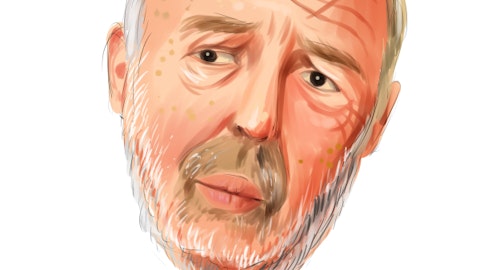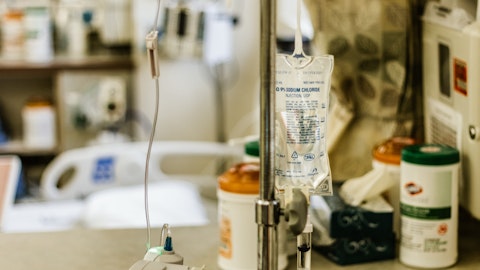Vertex Pharmaceuticals Incorporated (NASDAQ:VRTX) Q1 2023 Earnings Call Transcript May 1, 2023
Vertex Pharmaceuticals Incorporated beats earnings expectations. Reported EPS is $3.05, expectations were $3.
Operator: Good day, and welcome to the Vertex Pharmaceuticals First Quarter 2023 Conference Call. All participants will be in a listen-only mode. After today’s presentation, there will be an opportunity to ask questions. Please note, this event is being recorded. I would now like to turn the conference over to Ms. Susie Lisa. Please go ahead.
Susie Lisa: Good evening, all. My name is Susie Lisa, and as the Senior Vice President of Investor Relations, it is my pleasure to welcome you to our first quarter 2023 Financial Results Conference Call. On tonight’s call making prepared remarks, we have Dr. Reshma Kewalramani, Vertex’s CEO and President; Stuart Arbuckle, Chief Operating Officer; and Charlie Wagner, Chief Financial Officer. We recommend that you access the webcast slides as you listen to this call. The call is being recorded and a replay will be available on our website. We will make forward-looking statements on this call that are subject to the risks and uncertainties discussed in detail in today’s press release and in our filings with the Securities and Exchange Commission.
These statements, including without limitation, those regarding Vertex’s marketed cystic fibrosis medicines, our pipeline and Vertex’s future financial performance are based on management’s current assumptions. Actual outcomes and events could differ materially. I would also note that select financial results and guidance that we will review on the call this evening are presented on a non-GAAP basis. In addition, the impact of foreign exchange is presented inclusive of our foreign exchange risk management program. I will now turn the call over to Reshma.
Reshma Kewalramani: Thanks, Susie. Good evening, all, and thank you for joining us on the call today. We’re pleased to have opened with a strong start to 2023, as first quarter global CF product revenues grew 13% versus the first quarter of 2022. In addition, we completed the Exa-cel U.S. rolling BLA submissions for sickle cell disease and beta thalassemia and secured U.S. approval for TRIKAFTA in patients two years to five years of age. Now is an especially exciting time at Vertex because within our five launches in five years, or five in five goal, we see multiple programs with near-term launch potential including exa-cel and sickle cell disease and transfusion-dependent beta thalassemia, the vanzacaftor triple in CF, and VX-548 for acute pain.
In total, we now have programs in eight disease areas, in mid and late-stage development, six of which are past the proof-of-concept stage as depicted on slide five. With this breadth of compelling opportunities, we’re investing accordingly to drive continued pipeline success, clinical trial progress, and the buildout of commercialization capabilities. In addition, beyond the eight disease areas already in the clinic, the next wave of innovation is advancing through preclinical development, including programs in Duchenne’s muscular dystrophy, Myotonic dystrophy type 1, NAV1.7 for pain, and gentler conditioning agents for use with exa-cel. With a uniquely strong and durable CF franchise, multiple near-term commercial opportunities, a broad and rapidly advancing pipeline, a strong balance sheet, and an exceptionally talented and committed team, Vertex has never been as well-positioned to deliver for patients and shareholders for years to come.
With that overview, I’ll turn to the details of recent R&D progress starting with CF. Our next in-class vanzacaftor triple combination has completed enrollment in its two Phase 3 clinical trials in patients ages 12 years and above, known as SKYLINE 102 and SKYLINE 103 and is progressing well. Enrollment in patients ages six to 11 known as the RIDGELINE study is also advancing rapidly. We continue to anticipate the completion of the SKYLINE studies by the end of this year, and I’m pleased to share, we now project the completion of the RIDGELINE study at approximately the same time as the SKYLINE studies. Recognizing the very high bar set by TRIKAFTA, we have high expectations for the vanzacaftor triple program based on the totality of the evidence generated to-date, and as was recently reported in Lancet Respiratory Medicine.
Preclinically, our HBE assays which have consistently proven to have robust translation from the bench into the clinic showed greater restoration of chloride transport with the vanzacaftor triple than with TRIKAFTA. In the Phase 2 clinical program, the vanzacaftor triple drove greater CFTR function and correspondingly lower levels of sweat chloride that has been seen with TRIKAFTA. As such, we believe the vanzacaftor triple has the potential for enhanced clinical benefit along with the convenience of once-daily dosing. In addition, we expect the vanza triple to carry substantially lower royalty burden. Another important study in our CF portfolio pertains to VX-522, our CFTR mRNA therapy that we’re developing in partnership with Moderna for the more than 5,000 CF patients who cannot benefit from CFTR modulators.
We have initiated the single ascending dose or SAD study of VX-522 and are actively enrolling and dosing CF patients. We anticipate completing the SAD portion of the study and initiating the multiple ascending dose portion of the study this year. Turning now to exa-cel, our gene editing program for severe sickle cell disease and transfusion dependent beta thalassemia. exa-cel holds the potential to be the first CRISPR-based gene editing treatment to be approved, as well as the promise to be a one-time functional cure for these diseases. This is our most advanced program outside of CF and we expect exa-cel to be our next commercial launch. Per our prior guidance, we completed our BLA submissions for both sickle cell disease and TDT in the U.S. at the end of last quarter.
We now await acceptance of our filings and assignment of the PDUFA date. Our filings include requests for Priority Review, which if granted will result in an eight months review by FDA from the time of submission. Internationally, as previously announced, both the EMA and MHRA have validated our exa-cel MAA submissions, and those filings are under review. We see a significant opportunity for exa-cel. Stuart will comment further on the market opportunity and our launch preparations in just a few minutes. Turning next to our pain program and VX-548, our novel highly selective NaV1.8 inhibitor that holds the promise of effective pain relief without the side effects or addictive properties of opioids. We have confidence in the outlook for this program, given, one, NaV1.8 is a genetically and pharmacologically validated target.
Two, we have multiple positive proof-of-concept results with our predecessor NaV1.8 inhibitor VX-150 across acute, neuropathic, and musculoskeletal pain, and with VX-548 itself in acute pain. And three, our Phase 3 program with VX-548 in acute pain is substantially similar to the positive Phase 2 II trials we have already concluded. VX-548 has been granted Fast Track and Breakthrough Therapy designations for acute pain in the U.S. We initiated pivotal development last year and enrollment and dosing across the three Phase 3 studies continue to progress nicely. These studies have been designed to support our goal of a broad moderate-to-severe acute pain label that would enable prescribing and usage across multiple care settings, including at the site of care post discharge and in the home.
We continue to anticipate completing the acute pain Phase 3 pivotal program towards the end of this year or beginning of next creating another potentially significant and near-term commercial opportunity. In addition, we continue to enroll and dose patients in a twelve-week Phase 2 dose-ranging proof-of-concept study of VX-548 in diabetic peripheral neuropathy, a form of peripheral neuropathic pain. I am pleased to share, we also anticipate completing this Phase 2 study towards the end of this year or beginning of next. Transitioning now to inaxaplin or VX-147, the first potential medicine to target the underlying cause of APOL1-mediated kidney disease or AMKD. In March, we were very pleased with the publication of the Phase 2 results for inaxaplin in the New England Journal of Medicine.
Importantly, the paper was accompanied by an editorial and a feature on the science behind the study. We see this coverage in the New England Journal of Medicine as underscoring the importance of the inaxaplin data and the medicine’s potential. The Phase 2b dose ranging portion of the global Phase 2, 3 pivotal study remains on track to complete this year. Recall, this study has a preplanned interim analysis at 48-weeks of treatment, which, if positive, could serve as the basis to seek accelerated approval in the U.S. With inaxaplin, we see the potential to bring a first-in-class treatment to the approximately 100,000 patients with AMKD in the U.S. and Europe and unlock a multibillion-dollar market opportunity. Moving now to Type one diabetes.
There are more than 2.5 million people with Type one diabetes in North America and Europe alone, and we are committed to delivering a transformative, if not, curative medicine for this disease. We have three programs in our type one diabetes portfolio, all of which use the same fully differentiated insulin producing islet cells, which have already demonstrated proof-of-concept. Our first program or VX-880, the naked cell program use a standard immunosuppressive to protect the islet cells from the immune system. I am pleased to share that both part A and part B of the study are now fully enrolled and dosed. In both portions of the study, dosing of patients with staggered with Part A patients receiving half dose and Part B patients receiving the full target dose.
The next step in the program is Part C in which patients will be treated concurrently with the full target dose. This should facilitate faster timelines. We look forward to sharing VX-880 data from more patients and with longer duration of follow-up at medical congresses this year, including the ADA Scientific Sessions in June. Our second program, VX-264 or the cells plus device program encapsulates these same cells in a proprietary device that is designed to shield the cells from the body’s immune system, and hence there is no requirement for immunosuppressants. Both the IND in the U.S. and the CTA in Canada have cleared. Site activation and study initiation activities are underway in both the U.S. and Canada, and we look forward to enrolling and dosing patients in this Phase I, II study in the near-term.
Third, our hypoimmune program in which we added the same cells to cloak them from the immune system. This would represent another path to obviating the need for immunosuppressives. In March, we expanded our collaboration with CRISPR Therapeutics into type one diabetes and this new licensing agreement will enable us to use CRISPR-Cas9 to edit the cells. This research stage program continues to make progress. Lastly, also in the T1D portfolio, the ViaCyte VCTX-211 hypoimmune program using a ViaCyte cell line remains on track. This program is finished enrollment and dosing in Group one of the Phase 1, Phase 2 study. Let me conclude with our Alpha-1 Antitrypsin Deficiency or AATD program, which continues to enroll both the Phase 2 study for VX-864 and the Phase 1 study for VX-634.

Photo by freestocks on Unsplash
The Phase 2 program for VX-864 is a 40 eight week study in patients with AATD that will assess both liver clearance of the polymer and serum functional AAT levels. This study is projected to complete enrollment later this year. The Phase 1 healthy volunteer study of VX-634, the next in class molecule with multi-fold greater potency and better drug-like properties is projected to complete this year. With that, I’ll now turn over the call to Stuart.
Stuart Arbuckle: Thanks, Reshma. From a commercial perspective, our focus continues to be to reach all patients eligible for our CFTR modulators and maintain high levels of adherence among patients already on therapy, while also preparing for potential near term launches for exa-cel, VX-548 in acute pain, and the vanzacaftor triple combination in CF. I’ll first review our CF first quarter commercial results and then the longer term outlook for our CF portfolio. I will then comment on the exa-cel opportunity and our launch preparations, given that we have now completed our regulatory filings in the U.S., Europe, and the U.K. We had a strong first quarter with growth predominantly driven by bringing our medicines to younger patients, including TRIKAFTA in children ages six to 11 in the U.S., pus Europe and Canada, and we remain confident in the growth outlook for 2023.
Last week, as expected, we received FDA approval for TRIKAFTA in the U.S. for children ages two years to five years, which adds approximately 900 new patients who for the first time will have a treatment to address the underlying cause of their disease. Turning to the longer term outlook. We see continued growth in CF beyond 2023. As Reshma mentioned, at the beginning of this year, there were more than 20,000 people in North America, Europe, Australia, and New Zealand with CF who could benefit, but were not yet been treated with our approved medicines. Beyond the key growth driver of reaching younger patients through new approvals, we also continue to make progress in securing additional reimbursements. This includes multiple agreements spanning our CF portfolio for younger patients in Europe, and most recently also Australia and New Zealand.
A second driver of CF product growth is the compelling portfolio of real world outcome studies, including model data which validate the positive outlook for long term growth in the overall CF population due to improved survival. Model data related to projected survival and long term health outcomes were recently published in the Journal of Cystic Fibrosis and include a 33.5 year increase in median projected survival with TRIKAFTA therapy versus the standard of care. The third growth driver for our CF portfolio will be our next generation vanzacaftor triple, which provides an opportunity to bring a new and potentially improved treatment option to patients, including those who discontinued therapy with our other medicines. We estimate that there are approximately 6,000 patients who have discontinued one of our existing CFTR modulators.
And longer term, a fourth factor that helped drive extended growth in our CF portfolio is VX-522, which is designed to provide mRNA therapy for the more than 5,000 patients who cannot benefit from CFTR modulators. Shifting now to exa-cel, which holds curative potential for patients with sickle cell disease and transfusion-dependent beta thalassemia. With the recent completion of our exa-cel regulatory submissions in the U.S., Europe, and U.K., our commercial teams are preparing for the potential approval and launch of this multi-billion dollar opportunity. Sickle cell disease and transfusion-dependent beta thalassemia are neither silent nor undiagnosed diseases. Our initial launch will focus on the approximately 32,000 most severe patients in the U.S. and Europe.
These patients have been sick their entire lives with a chronic often disabling disease that carries a high burden of care. They could soon have the opportunity for a potential lifetime cure. Our launch preparations are informed by extensive market research and insight generation, including through direct engagement with patients, providers, and payers to understand their perceptions of gene therapy and the potential uptake of a product like exa-cel. We are encouraged by the strong interest and enthusiasm shown by all stakeholders for a genetic therapy that could provide transformative benefit for patients. Starting with patients. The journey for someone to receive exa-cel can be summarized in three key phases. One, the pre-treatment period where patients decide a genetic therapy is right for them, and are referred to an authorized treatment center by their hematologists and begin the cell collection process.
Two, the manufacturing period where a patient cells are edited and become the exa-cel drug product. And three, the treatment period where a patient receives myeloablative conditioning, then their edited cells, and is followed for successful engraftment. Survey data from sickle cell and beta thalassemia patients indicate that more than a quarter strongly believe genetic therapy is the right choice for them. Of the balance, the vast majority want to learn more about future treatment options through their own research and through the lived experience is of exa-cel patients and their treating physicians. With providers, we’ve learned there is a clear recognition of the differences between various genetic therapy approaches and a strong preference for gene edited therapies like exa-cel over gene insertion approaches using lentivirus.
Our market research suggests that approximately 70% of providers prefer a gene editing approach over other gene therapy mechanisms. Our teams are focused on providing access to key support and systems for both patients and providers to ensure the best possible treatment experienced. Accordingly, we have made strong progress toward ensuring authorized treatment centers are administratively and logistically prepared to initiate the exa-cel treatment journey for patients upon approval. Approximately 50 U.S. centers are actively engaged in the process to become an ATC located in those areas with the highest prevalence of patients. Similarly. in all four key European markets, all 25 targeted ATC sites are in process. Payers are another important area of focus.
We are actively engaging with key commercial and government payers and policymakers in the U.S. and Europe. First, with regard to commercial payers in the U.S. Our conversations are focused on the patient need and clinical profile of exa-cel including dramatic reductions in VOCs and hospitalizations for sickle cell disease patients and in transfusions for beta thalassemia patients. We are confident that payers will recognize exa-cel’s value in patient populations where current lifetime cost of care can exceed $4 million. We are working with insurers to ensure broad access for the approximately 35% of sickle cell disease and transfusion-dependent thalassemia patients who are commercially insured. Now to government payers. Approximately 45% of severe sickle cell disease patients in the U.S. are insured by Medicaid and thus, we’ve also been working with state agencies to ensure Medicaid patients have broad access to exa-cel.
We recognize that a critical element for adoption is ensuring a separate payment for the exa-cel therapy in addition to the reimbursement already in place for the transplant procedure costs. Encouragingly, many states are already providing access to cell and gene therapies with separate payment policies for the procedure and the therapy, and we continue to engage with state agencies around payment models ahead of the launch. In addition, in February of this year, the Biden administration demonstrated their commitment to ensuring access to cell and gene therapies like exa-cel through the announcement of a CMS demonstration project called the Cell and Gene Therapy or CGT access model. The CGT access model will be administered through CMS’s innovation center, which is a total budget of approximately $10 billion for the exploration and testing of novel delivery methods and approaches intended to accelerate and enhance broad Medicaid access for sickle cell disease patients.
The CGT access model will overtime facilitate this in two important ways, by creating a pathway for state Medicaid agencies to delegate authority to CMS to coordinate and facilitate innovative payment models including outcomes-based agreements or OBAs with cell and gene therapy manufacturers like Vertex. And in addition, CMS has confirmed any outcomes based arrangement for inpatient therapies requires payment separate from the hospital inpatient bundle. We view the CGT access model as an important indicator of the understanding of the severity of these diseases and the need to provide broad access to potentially transformative therapies for these historically underserved patient populations. We are extremely excited about the potential for exa-cel, our first commercial launch outside of CF in many years and look forward to updating you further on our launch preparation activities on future calls.
I’m also looking forward to updating you on our continued progress to discover, develop. and secure access to transformative medicines for all people living with CF. I will now turn the call over to Charlie to review the financials.
Charlie Wagner: Thanks, Stuart. Vertex’s results in the first quarter of 2023 demonstrate our consistent strong performance and attractive growth profile regardless of macroeconomic conditions. First quarter 2023 revenue increased 13% year-over-year to $2.37 billion. Growth was led by a 33% year-over-year increase outside the U.S. on continued strong uptake of TRIKAFTA/KAFTRIO in markets with recently achieved reimbursement, as well as label extensions into younger age groups. U.S. CF revenue grew 3% year-over-year with ongoing consistent performance. First quarter 2023 combined non-GAAP R&D, acquired IPR&D, and SG&A expenses were $1.2 billion compared to $687 million in the first quarter of 2022. Q1, 2023 results include $347 million of acquired IPR&D charges, compared to just $2 million of such charges in the first quarter of 2022.
First quarter 2023 IPR&D expenses resulted from several new collaborations, which augment our internal innovation efforts as detailed on slide 15, including collaborations with Entrada Therapeutics and DM1 ImmunoGen for gentler conditioning agents and the expansion of our relationship with CRISPR Therapeutics into Type one diabetes. Aside from our investments in external innovation and the resulting higher acquired IPR&D charges, operating expense growth was driven as expected by continued investment in research in our advancing pipeline, which includes mid and late stage clinical assets across eight different disease areas. For example, these investments are directed towards clinical studies for the vanzacaftor triple in CF, VX-548 in acute pain, and type one diabetes, as well as pre-commercial build-out activities for exa-cel and other potential near-term launches.
Given the potentially transformative benefit to patients and multibillion-dollar market opportunities for our programs, we will continue to invest appropriately. First quarter 2023 non-GAAP operating income was $902 million in the quarter, compared to $1.17 billion in the first quarter of 2022. First quarter adjusted earnings per share were $3.05. We ended the quarter with $11.5 billion in cash and investments, as our cash flow generation and balance sheet remain very strong. Now switching to guidance. Given our first quarter results and our consistent execution, there are no changes to our 2023 financial guidance as detailed on slide 16. We continue to expect product revenue guidance of $9.55 billion to $9.7 billion, representing 7% to 9% growth year-over-year.
Note that, this guidance continues to include an expected approximate 1.5 percentage point headwind to our revenue growth, inclusive of our foreign exchange risk management program. As we mentioned in early February, given our years of experience in CF, we have strong visibility to our 2023 revenue guidance range, which is inclusive of expected new approvals like the TRIKAFTA U.S. approval in patients ages two to five and new reimbursements outside the U.S. Note too that 2023 product revenue guidance continues to reflect revenue from cystic fibrosis products only. Exa-cel is not included in guidance as potential approval and launch dates in the EU, UK and US are still to be determined. We are also reiterating our 2023 guidance for combined non-GAAP R&D, acquired IPR&D, and SG&A expenses in the range of $3.9 billion to $4 billion.
Our 2023 non-GAAP operating expense guidance now includes approximately $400 million of upfronts and milestones from previously existing or recently completed BD transactions versus the $300 million that was anticipated at the beginning of the year. Our operating expenses continue to be more than 70% allocated to R&D and are funding the significant continued progress of our multiple mid and late stage clinical development programs. Additionally, we are funding the expansion of our commercialization capabilities in anticipation of the multibillion dollar market opportunities represented by our programs with near term launch potential. Our guidance for projected full year 2023 non-GAAP effective tax rate of 21% to 22% is also unchanged. In closing, Vertex performed exceptionally well in the first quarter of 2023.
We delivered strong revenue growth, invested internally and externally, and accelerated programs across our diverse pipeline. We’re also proud of our industry leading culture of innovation that we believe will continue to drive long term success. A few highlights from our recently published Corporate Responsibility Report are found on slide 17. And as we continue to advance our programs in 2023, we anticipate further important milestones as highlighted on slide 18 to mark our continued progress in multiple disease areas. We look-forward to updating you on our progress on future calls. And I’ll ask Susie to begin the Q&A period.
See also 30 Most Expensive Cities Around the World to Rent an Apartment and 20 Cities with the Highest Depression Rates in the U.S..
Q&A Session
Follow Vertex Pharmaceuticals Inc / Ma (NASDAQ:VRTX)
Follow Vertex Pharmaceuticals Inc / Ma (NASDAQ:VRTX)
Operator: We will now begin the question-and-answer session. And the first question will come from Salveen Richter with Goldman Sachs. Please go ahead.
Salveen Richter: Good afternoon. Thanks for taking my question. With regard to the exa-cel launch, you discussed the three steps that need to occur for patients to get treatment here. Could you just speak to the overall time that will be required in your mind after approval for a patient to actually be administered drug? And then secondly, the gene insertion competitor clearly has been doing work here and it’s taken some time, but they’ve done foundational payer work. Just wondering what the read through is from all the work they’ve done to your launch progress as well. And in the context of this on the R&D and SG&A front, as we look to next year, how do we think about how that SG&A line might inflect in the context of not just this launch, but also the pain launch as well? Thank you.
Reshma Kewalramani: Salveen, thanks very much for the question. I’m going to ask Stuart to talk about the exa-cel timelines and a little bit about the launch. Stuart?
Stuart Arbuckle: Yes, so Salveen, as I outlined in my prepared remarks, this is a relatively extended process that takes multiple months from beginning to end. As I said, from the patient deciding with their physician with a genetic approach is the one that they would like to undertake through mobilization and the manufacturing then very, very importantly the last step which is obviously the most important because that’s when they are infused with their edited cells because of the nature of that loss that’s where the patient if they want to go myeloablative conditioning and therefore has a multi week stay in the hospital once they’re followed to see whether the product has ingrafted before they are released from the hospital, they have to schedule that into their life, and so that is obviously a very significant undertaking for an individual.
But, of course, the payoff there is they’re looking to get a potential lifetime cure for that multi-month process. So it is a multi-month process with that last step obviously been one, if they need to schedule into their life. Hopefully, then to receive a lifetime of benefit from exa-cel. In terms of what do we learning from the marketplace more interaction with payers, we’re incredibly encouraged by the reaction we’ve had from payers both their understanding of the severity of both sickle cell disease and transfusion-dependent thalassemia and the very significant burden that it has on patients, their families, and of course, the broader healthcare system and the cost associated with that. Also, we’re very encouraged by their reaction to the product profile that exa-cel has and how positive they appear to be working with us to try and ensure that there is as nearest possible access to that exa-cel is close to possibly post approval.
So we’re really very encouraged by the response from there across the continuum, commercial payers, and very importantly for this population both Medicaid and Medicare. I think you had a question on SG&A evolution. I think that’s probably best handled by Charlie. So Charlie, do you want to take that one?
Charlie Wagner: Yes, Salveen, thanks. Given that we’ve just reiterated our 2023 OpEx guidance, you can expect, I’m not going to have much to comment on about 2024. I will say that the growth in OpEx in 2023, of course, is driven by the advancements in the pipeline, we’ve got multiple programs in mid and late stage including a few that are very close to commercialization. Even with that the majority, over 70% of our OpEx is invested in R&D. Looking ahead, as we have more programs moving towards commercialization, you could see a little bit of a mix shift towards commercial spend, but importantly, with our model of focusing on transformative medicines in specialty populations, we always expect that SG&A burden on the business would be quite low. It gives us the ability to drive significant profitability over time.
Salveen Richter: Thank you.





